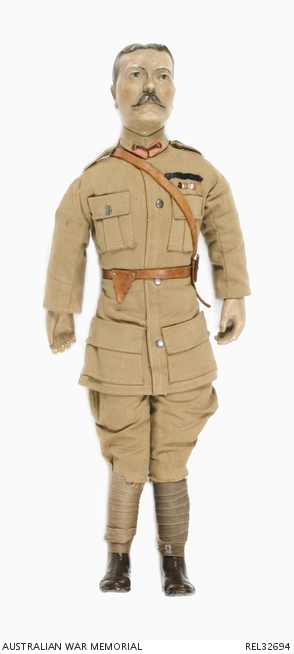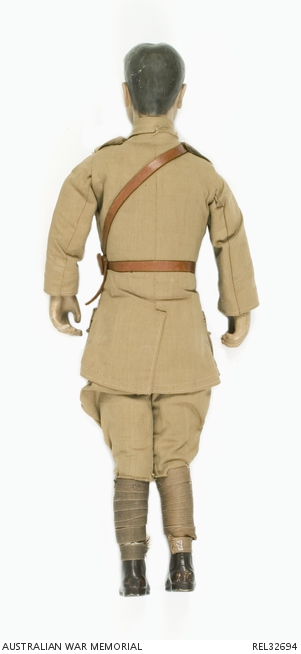| Accession Number | REL32694 |
|---|---|
| Collection type | Heraldry |
| Object type | Heraldry |
| Physical description | Cardboard, Ceramic, Cotton drill, Felt, Gold bullion braid, Leather, Nickel-plated steel |
| Maker |
Lord Roberts Memorial Workshop for Disabled Soldiers & Sailors Lord Roberts Memorial Workshop for Disabled Soldiers & Sailors |
| Place made | United Kingdom |
| Date made | 1914-1916 |
| Conflict |
First World War, 1914-1918 |
Lord Kitchener bisque-headed patriotic doll: George Long




Large scale doll featuring bisque head, and possibly composition hands and feet; with a painted character head in the likeness of Lord Kitchener. Doll is supplied with an officer's cap made from khaki cotton drill, leather, gold braid and red felt on a thick card base. The tunic and knee-length breeches are also made from cotton drill and feature four patch pockets, with nickel-plated paper fasteners for buttons, real leather Sam Browne belt and holster, red felt collar tabs and a length of scrap medal ribbon under a blue band sewn to the left breast to represent Kitchener's medals. A length of 13 mm wide khaki cotton tape is wrapped round each leg to represent puttees. The composition boots are painted dark brown. The doll's body is cloth with a wadding fill, to which the hands, feet and head have been sewn.
A product of the Lord Roberts Workshops in England, which were set up during the First World War to provide employment to disabled soldiers and sailors, this doll was a popular feature of their "Patriotic" series. It was purchased by George Long, a former Buckingham Palace valet who emigrated with his family to Australia in 1912. Long's daughter Joyce was born a year later and the doll was passed onto her. Long may have met Kitchener in his role as Royal valet. Kitchener initially rose to prominence upon becoming Commander-in-Chief of the Egyptian army and taking the city of Khartoum in 1898 after a two year battle which earned him the nickname of "Kitchener of Khartoum". He cemented his reputation towards the end of the Boer War, during which time Australian troops came into contact with him.
From 1902 -1909, Field Marshall Viscount Kitchener commanded Britain's Indian forces. In 1909/10 he visited Australia at the invitation of Prime Minister Alfred Deakin to inspect and advise on the country's defence preparedness. Kitchener's report, submitted in February 1910, recommended the introduction of compulsory military training which was immediately adopted, as was the establishment of the Military College, Duntroon. His visit was accompanied by popular outpourings of sentiment and the production of countless souvenirs. The British government had no hesitation in appointing Kitchener the Secretary of State for War in 1914, employing his face on the now famous "I Want You" recruiting posters and handing him the administration of all British Forces.
Against his better judgement, and under considerable pressure from Winston Churchill, Kitchener agreed to support the Gallipoli campaign in February 1915, but its disastrous outcome damaged his military reputation. His tour of Gallipoli on 13 November 1915 included meeting Australian troops and their commanders. Kitchener died on 5 June 1916, when the cruiser he was sailing on was sunk by a German mine off Scapa Flow.